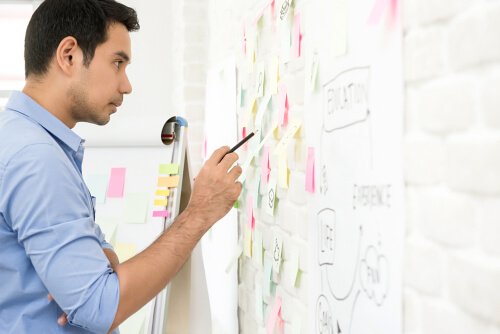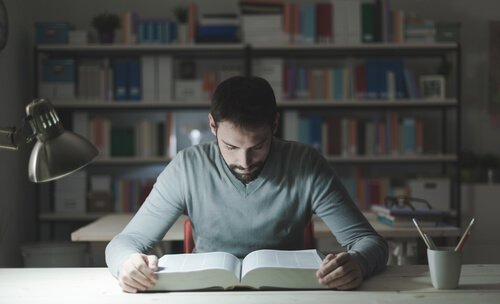Self-Regulated Learning: What Is it and Why Is it Important?

Self-regulated learning is closely related to the way in which people regulate their emotions, cognitions, behaviors, and environmental aspects during a learning experience. Furthermore, we know that it’s important to be able to control your mind in terms of learning processes. The sooner you learn to do it, the more successful and gratifying your educational experience will be.
There are many self-regulation skills. Some of them are good time management, the ability to select the best problem-solving strategies, and the ability to actively control emotional states such as frustration.
“Learning is about one’s relationship with oneself and one’s ability to exert the effort, self-control, and critical self-assessment necessary to achieve the best possible results.”
-Linda B. Nilson-
Definition of self-regulated learning
Barry Zimmerman is one of the most important researchers in the field of self-regulated learning. He asserts that self-regulation isn’t a mental or academic performance skill. Rather, it’s a self-direction process through which students can transform their mental skills into academic skills.

According to Zimmerman, self-regulated learning involves not only attaining a detailed knowledge of an ability, but also other skills such as self-awareness, self-motivation, and the ability to behave in a way that it’s possible for you to apply what you learned appropriately.
Novice students assess themselves by comparing themselves to others and receiving feedback from them. They also frequently attribute failures to deficiencies they have no control over. On the other hand, experienced students who know how to manage their own learning accept that they’ve failed when they have. Instead of blaming their failure, though, they focus on how they can fix their weak points.
Looking at it from another angle, self-regulation isn’t something some students have and others don’t. According to Zimmerman, self-regulation consists of applying specific processes selectively to each learning task. These have to be selected on the basis of personal characteristics. That’s why it’s best to talk about self-regulation in the context of learning or some determined type of learning.
Self-regulated learning involves establishing goals and then choosing the right strategies to reach them. Once chosen, you have to monitor your progress and restructure your techniques if you’re not meeting your goals. You also have to use your available time efficiently, evaluate the methods you’ve chosen, and adapt your methods to future learning. Of course, you should always apply the new things you have learned to future endeavors.
Self-regulated learning skills
Self-regulated learning skills are essential tools for learning. Nevertheless, educators rarely teach them explicitly. This is why many students end up lacking independence, motivation, persistence, and a positive feeling of well-being during their studies. For educators to transmit these skills effectively to their students, it’s important for them to be intimately familiar with the most important self-regulation mechanisms.
Students go through three main stages when they regulate their own learning: planning, performing, and reflecting. These stages aren’t necessarily successive. The students can pass through many cycles throughout the course of a learning task.

- During the planning stage, the students establish their goals and standards. They should be able to meet them within the span of a specific task, session, or course. This stage involves the student’s perception of the learning environment.
- During the performance stage, the students demonstrate their commitment to their learning experience. At this point, they monitor their own learning. They can compare their progress with the standards they established in the planning stage.
- During the reflection stage, the students think about and evaluate their learning experience. This includes reflecting over feedback and mentally storing ideas and concepts for use in future learning.
Educators and self-regulated learning
Given the importance of self-regulated learning, it’s essential that professors teach these skills explicitly. They must also offer strategies to help students apply them during the learning process. Part of this teaching process should include:
- Explaining the usefulness and importance of self-regulated learning skills.
- Explicitly teaching self-regulated learning strategies.
- Helping students identify when and how they can use these self-regulated learning skills.
A 2012 study by Dignath-van Ewijk, C, and Van Der Werf, G that focused on teachers’ self-regulated learning beliefs and behaviors demonstrated that teachers believe in passing these skills onto their students. The results of the study highlighted how teacher training would provide them with the skills and knowledge to promote self-regulated learning effectively.
We should develop strategies for educators to be able to teach self-regulated learning skills to students. This would include tools, resources, and strategies they can use in the classroom.
Self-regulated learning is closely related to the way in which people regulate their emotions, cognitions, behaviors, and environmental aspects during a learning experience. Furthermore, we know that it’s important to be able to control your mind in terms of learning processes. The sooner you learn to do it, the more successful and gratifying your educational experience will be.
There are many self-regulation skills. Some of them are good time management, the ability to select the best problem-solving strategies, and the ability to actively control emotional states such as frustration.
“Learning is about one’s relationship with oneself and one’s ability to exert the effort, self-control, and critical self-assessment necessary to achieve the best possible results.”
-Linda B. Nilson-
Definition of self-regulated learning
Barry Zimmerman is one of the most important researchers in the field of self-regulated learning. He asserts that self-regulation isn’t a mental or academic performance skill. Rather, it’s a self-direction process through which students can transform their mental skills into academic skills.

According to Zimmerman, self-regulated learning involves not only attaining a detailed knowledge of an ability, but also other skills such as self-awareness, self-motivation, and the ability to behave in a way that it’s possible for you to apply what you learned appropriately.
Novice students assess themselves by comparing themselves to others and receiving feedback from them. They also frequently attribute failures to deficiencies they have no control over. On the other hand, experienced students who know how to manage their own learning accept that they’ve failed when they have. Instead of blaming their failure, though, they focus on how they can fix their weak points.
Looking at it from another angle, self-regulation isn’t something some students have and others don’t. According to Zimmerman, self-regulation consists of applying specific processes selectively to each learning task. These have to be selected on the basis of personal characteristics. That’s why it’s best to talk about self-regulation in the context of learning or some determined type of learning.
Self-regulated learning involves establishing goals and then choosing the right strategies to reach them. Once chosen, you have to monitor your progress and restructure your techniques if you’re not meeting your goals. You also have to use your available time efficiently, evaluate the methods you’ve chosen, and adapt your methods to future learning. Of course, you should always apply the new things you have learned to future endeavors.
Self-regulated learning skills
Self-regulated learning skills are essential tools for learning. Nevertheless, educators rarely teach them explicitly. This is why many students end up lacking independence, motivation, persistence, and a positive feeling of well-being during their studies. For educators to transmit these skills effectively to their students, it’s important for them to be intimately familiar with the most important self-regulation mechanisms.
Students go through three main stages when they regulate their own learning: planning, performing, and reflecting. These stages aren’t necessarily successive. The students can pass through many cycles throughout the course of a learning task.

- During the planning stage, the students establish their goals and standards. They should be able to meet them within the span of a specific task, session, or course. This stage involves the student’s perception of the learning environment.
- During the performance stage, the students demonstrate their commitment to their learning experience. At this point, they monitor their own learning. They can compare their progress with the standards they established in the planning stage.
- During the reflection stage, the students think about and evaluate their learning experience. This includes reflecting over feedback and mentally storing ideas and concepts for use in future learning.
Educators and self-regulated learning
Given the importance of self-regulated learning, it’s essential that professors teach these skills explicitly. They must also offer strategies to help students apply them during the learning process. Part of this teaching process should include:
- Explaining the usefulness and importance of self-regulated learning skills.
- Explicitly teaching self-regulated learning strategies.
- Helping students identify when and how they can use these self-regulated learning skills.
A 2012 study by Dignath-van Ewijk, C, and Van Der Werf, G that focused on teachers’ self-regulated learning beliefs and behaviors demonstrated that teachers believe in passing these skills onto their students. The results of the study highlighted how teacher training would provide them with the skills and knowledge to promote self-regulated learning effectively.
We should develop strategies for educators to be able to teach self-regulated learning skills to students. This would include tools, resources, and strategies they can use in the classroom.
All cited sources were thoroughly reviewed by our team to ensure their quality, reliability, currency, and validity. The bibliography of this article was considered reliable and of academic or scientific accuracy.
Zimmerman, B. J. (2002). Becoming a Self-Regulated Learner: An Overview. Theory Into Practice. https://doi.org/10.1207/s15430421tip4102_2
Zimmerman, B. J. (1990). Self-Regulated Learning and Academic Achievement: An Overview. Educational Psychologist. https://doi.org/10.1207/s15326985ep2501_2
Puustinen, M., & Pulkkinen, L. (2001). Models of Self-regulated Learning: A review. Scandinavian Journal of Educational Research. https://doi.org/10.1080/00313830120074206
Zimmerman, B. J. (1989). A Social Cognitive View of Self-Regulated Academic Learning. Journal of Educational Psychology. https://doi.org/10.1037/0022-0663.81.3.329
Dignath-van Ewijk, C., & van der Werf, G. (2012). What Teachers Think about Self-Regulated Learning: Investigating Teacher Beliefs and Teacher Behavior of Enhancing Students’ Self-Regulation. Education Research International. https://doi.org/10.1155/2012/741713
This text is provided for informational purposes only and does not replace consultation with a professional. If in doubt, consult your specialist.







